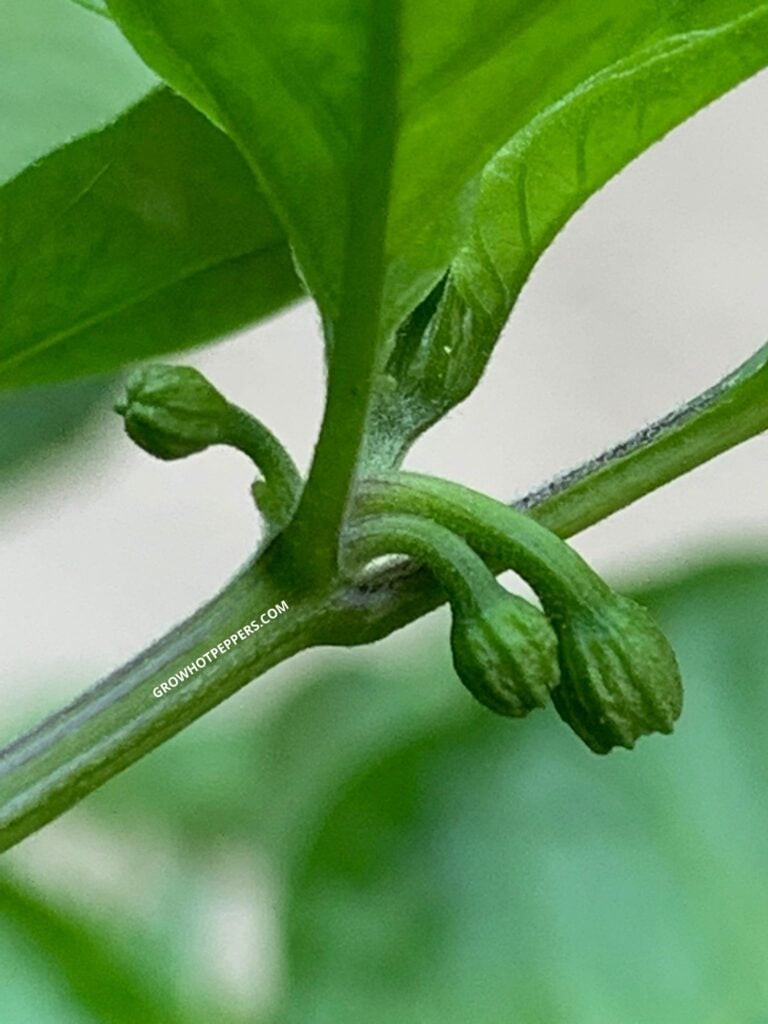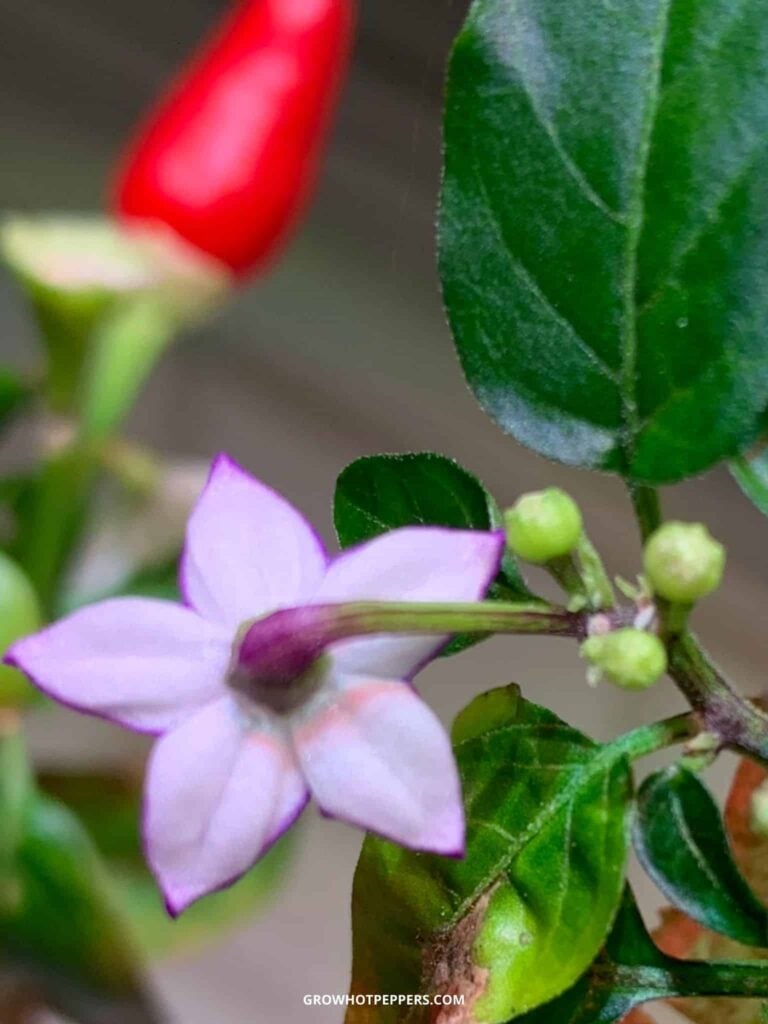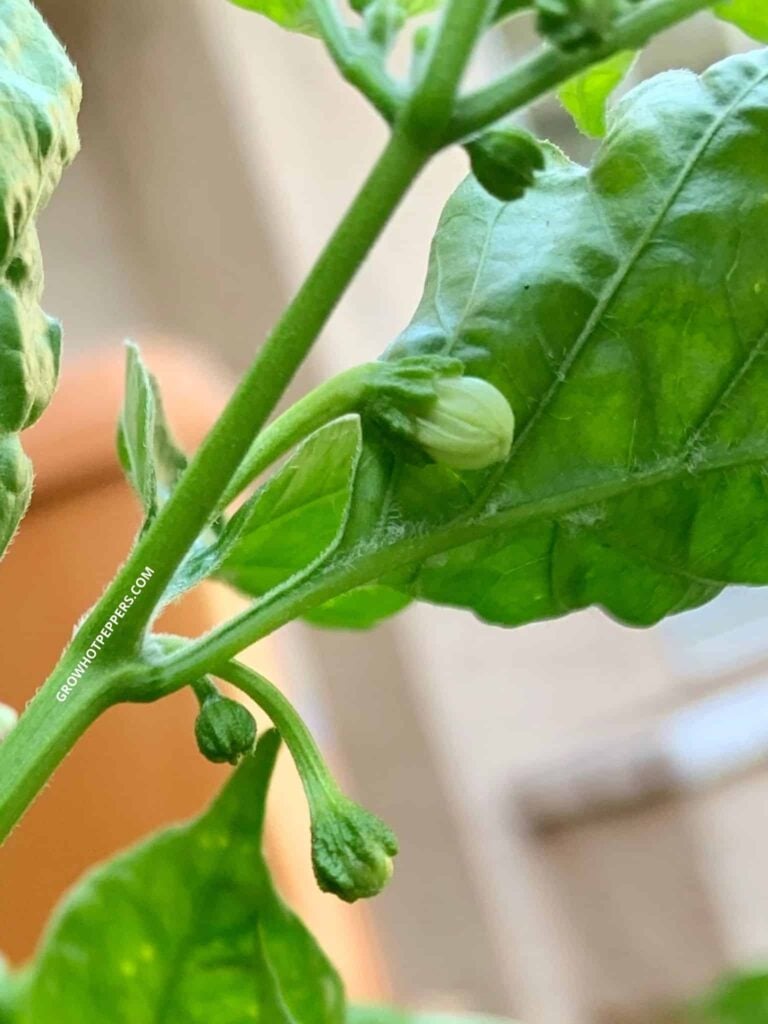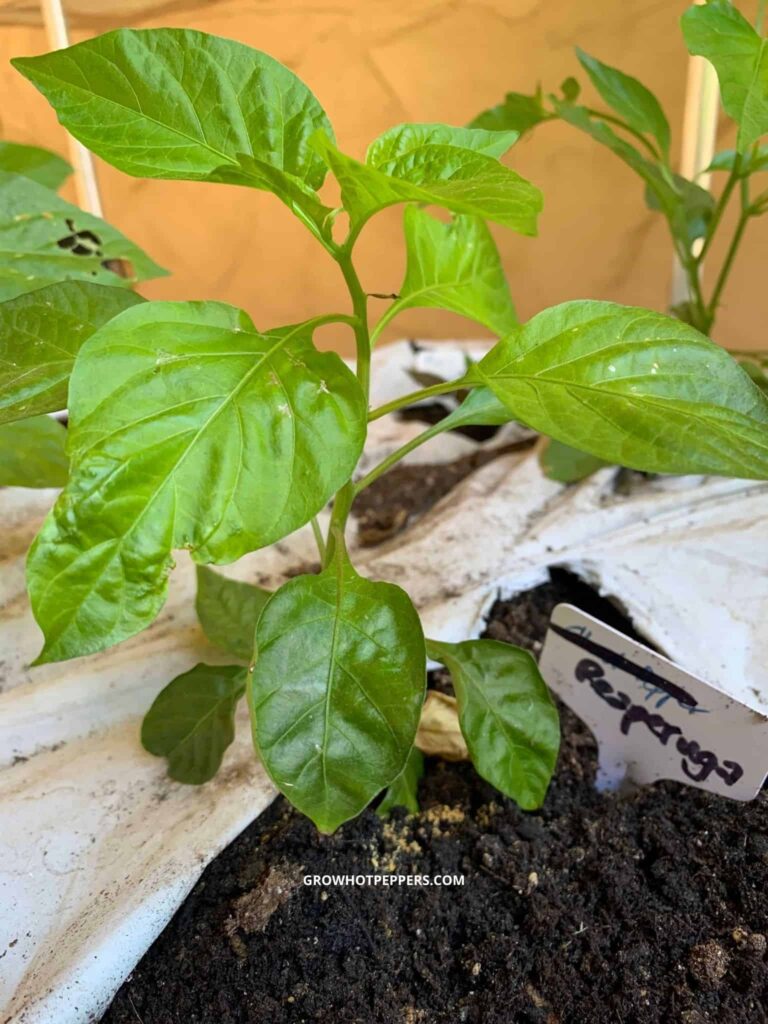Pinching pepper plants is when you remove the buds and flowers on younger plants. The idea is that more energy goes into growing stronger branches that can support lots of chillies. This guide explains when and how to pinch off pepper plant flowers if you decide to try it.

Should I pinch my pepper plants? This might seem like a bizarre question if you’re new to gardening. Some people (myself included) believe that pinching pepper buds and flowers helps you get more chillies during the growing season.
(And, given that it takes a lot of time to go from pepper plant to harvest, it’s nice to get a bigger payback.)
I pinch back pepper seedlings, but not all growers do. It’s a pretty divided topic on pepper forums.
The first step is to learn more about pepper plant flowers so you can decide what’s right for your plants.
Let’s dive in!
Grow Hot Peppers is reader-supported. When you buy through links on our site, we may earn a monetary commission. Learn more.
When Do Pepper Plants Flower?

Chilli plants bloom during the warmer spring and summer months, but it’s possible for seedlings to start budding indoors. So, what triggers pepper plants to flower? When the plant begins to branch, flowers begin to form. [1]
Besides the “when,” another question is why do some pepper plants flower early? (You may notice this if you start peppers indoors or when the plants are just too small to support growing fruit.) Early budding isn’t unusual, but inconsistent temperatures, inadequate fertilizer and the stress of being in small pots can contribute to premature flowers.
» Related – Transplanting Pepper Plants: When and How to Move Chillies to Bigger Pots
On the flip side, why is a pepper plant not flowering? Flower growth can stunt when daytime weather is too warm (over 90 degrees Fahrenheit, 32 degrees Celsius) and nighttime temperatures are too cold (less than 60 degrees Fahrenheit, 16 degrees Celsius). Pepper plants also need at least eight hours of sun a day.
grow tips
Fertilizer is a big part of why a pepper plant may or may not flower. This fertilizing pepper plants guide explains how to feed your plants. Alternately, you can use a product like FoxFarm’s nutrient trio that provides solutions for specific stages of plant growth.
Do Peppers Need Pinching Out?

Many sources recommend pinching off pepper flowers to get bushier plants and a more abundant harvest. [2, 3] This way, you get more than just a few chillies on your plant. Some growers feel that peppers don’t need pinching because the plant will likely drop these early buds on its own.
(I don’t believe there’s a right or wrong answer here. In the early stages, I choose to pinch out my chilli plants.)
In the next section, you’ll get some help deciding if you should remove pepper flowers. This applies whether you grow your own pepper seedlings or you buy pepper transplants (starts) at a nursery.
Should I Pinch Off Early Pepper Flowers?

If you notice your pepper plant flowering too early, you can start pinching off the first buds and flowers.
Here are some things to consider before you do this:
- Timing of your growing season: Do you have enough time for flowers to develop into chillies before the first expected frost? (See Grow Tips below.)
- Slow-growing pepper varieties: Superhots like Ghost peppers take a long time to produce. If you have starter plants and it’s further along in the growing season, don’t prune the flowers. (You don’t want to miss out on a harvest.) On the other hand, pinching bell pepper flowers and other fast-growing chillies should be fine.
grow tips
Generally, it can take two months to go from flower bud to pod, depending on the weather. Hot peppers plants may need even more time. Capsicum annuum varieties (e.g, Bell peppers, Jalapenos and Cayenne pepper plants) produce mature green pods within 35 to 50 days after flowers are pollinated. [4]
When Should You Pinch Pepper Plants?

The best time to start pinching out pepper seedlings is before transplanting them outside. Removing buds and flowers stops the plant from developing fruit and sends the energy back into the root system.
Pepper plants usually self-prune and drop early flowers on their own. Sometimes you’ll get highly motivated flowers that start growing pods.
Besides pinching indoor chile plants, you can also remove blossoms for two to three weeks after transplant. (Again, this depends on your growing season.) Continued pinching keeps the energy going back to the roots while your pepper plant gets used to being outside.
grow tips
When pinching off pepper flowers, you can expect to delay the harvest by over a week (roughly).
Where Do You Pinch Pepper Plants?

Pepper flowers grow in clusters on branches throughout the plant. You’ll typically spot these buds, blossoms and even tiny pods around the new leaves. How to pinch a pepper plant is very straightforward: you only need your fingers.

When pinching buds off pepper plants, place your thumb and forefinger on the bud or flower stem and gently clip it off. (You may need to hold the branch with your other hand to steady the seedling as you go.) If the pepper blossom is tiny, you can wait for the flowers to grow bigger or use tweezers to pluck them.
When To Stop Pinching Pepper Flowers

You can stop pinching peppers when the plant has a mature enough structure to support growing chillies. This means a bushier plant with stronger roots and branches. It’s also important to consider how many months you have left to grow.
Here are some general guidelines for when to stop pinching pepper plants:
- Your plants have already been transplanted outside for a couple of weeks OR
- Plants are around 12 inches tall OR
- You’re happy with the size of your plants OR
- You don’t have at least two months left in the growing season (ideally three months if growing superhots)
Just to clarify, these guidelines probably won’t apply at the same time. Stop pinching peppers when your plants meet any of these conditions.
grow tips
When pepper plants are ready for flowers, use a lower-nitrogen fertilizer to encourage more blooms and fruit rather than leafy growth. Fish emulsion or Tiger Bloom in Foxfarm’s Nutrient Trio can both meet these needs.
Common Issues With Pepper Plant Flowers
Here’s what happens to pepper plant flowers during the growing season.

Pepper Plant Flowers But No Fruit
Reasons: Lack of pollination and/or sunlight. Plants have too much nitrogen and not enough phosphate and potassium. Nighttime temperatures are above 86 degrees Fahrenheit [5]

Pepper Plant Flowers Falling Off
Reasons: Too much water, Lack of pollination, Hot weather, Humidity is too high/too low

Pepper Plant Flowers Turning Brown
Reasons: Browning flower petals can mean fruit is setting; It’s normal for some flowers to turn brown and drop off; Otherwise: Hot weather, Lack of pollination
grow tips
- Pepper flowers self-pollinate, which means they have both female and male parts. If pollination or humidity is an issue, you can hand pollinate plants by using a small paintbrush or your finger. Lightly brush the inside of the flower to help move pollen around.
- Hot weather is a common reason for blossom drop. When daytime temperatures go above 90 degrees Fahrenheit (32 degrees Celsius) blossoms can dry up and fall off. [6]

Pinching Peppers FAQs
What’s Next?
To recap, pinching pepper plant flowers isn’t absolutely necessary. It comes down to whether you want earlier fruit or more peppers in the long run.
If you have indoor pepper plants, your next step is to harden off seedlings so that they’re ready for the outdoors. Otherwise, visit the Growing Peppers In Containers page for all topics on growing chillies.
More In This Series:
- How to Care for Pepper Seedlings after Seeds Sprout
- When to Pick Peppers (& How) + 2 Ways to Store Your Chillies
- Growing Peppers from Seed to Harvest – The Ultimate Guide
Sources:
[1]: (DeWitt, Dave and Paul W. Bosland, The Complete Chile Pepper Book, Timber Press, 2009, p. 104)
[2]: “Capsicum annuum,” NC State Extension
[3]: “Peppers,” University of Maryland Extension
[4]: (DeWitt, Dave and Paul W. Bosland, The Complete Chile Pepper Book, Timber Press, 2009, p. 35)
[5]: (DeWitt, Dave and Paul W. Bosland, The Complete Chile Pepper Book, Timber Press, 2009, p. 104)
[6]: “Pepper,” Texas A&M AgriLife Extension

